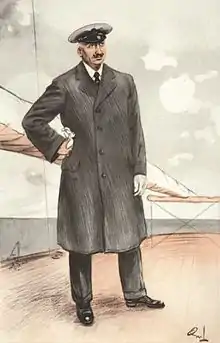Charles Allom
Sir Charles Carrick Allom (1865–1947), grandson of architect Thomas Allom and painter Thomas Carrick, was an eminent English decorator, trained as an architect and knighted for his work on Buckingham Palace. Among his American clients in the years preceding World War I was Henry Clay Frick, for whom Allom furnished houses in cooperation with Sir Joseph Duveen, the eminent paintings dealer. Allom furnished the Henry Clay Frick House at 71st Street and Fifth Avenue[1] that today houses the Frick Collection, and the neo-Georgian house, "Clayton", in Roslyn, Long Island, designed by Ogden Codman, Jr., that was bought for Frick's daughter-in-law.[2] For the grand rooms of parade in Frick's New York house,[3] Sir Charles, whose London workshops produced the plasterwork and boiseries, kept the furnishings muted, not to compete with Frick's collection of paintings. In 1925, when William Randolph Hearst purchased a real castle, St. Donat's in Wales, his choice to furnish it fell upon Sir Charles.[4]
Sir Charles Allom | |
|---|---|
 | |
| Born | 16 June 1865 Kensington, London, England |
| Died | 1 June 1947 (aged 81) Potter's Bar, Middlesex, England |
| Nationality | British |
| Occupation | Decorator and architect |
Biography
In 1914, Allom and Charles Ernest Nicholson of Camper and Nicholsons, a boat-building firm, formed the Gosport Aircraft Company. The firm built a number of flying-boats for the British government and proposed a series of designs during 1919. The venture closed in 1920 following the death of its chief designer, flying boat pioneer John Cyril Porte.
Shortly after World War I, Allom decided that he needed a more prominent position in New York. He purchased the house on Madison Avenue built by Carrère and Hastings in 1893 for Dr. Christian Herter[5] which the firm White, Allom & Company occupied until 1933. Allom divided his time between London and New York[6] In 1931, White, Allom was among the stellar cast of furnishers and decorators creating a grand but homey atmosphere for the new Waldorf-Astoria Hotel on Park Avenue.
The style generated by Allom, White was distinctly old-fashioned. It appealed to Queen Mary, who was a connoisseur of eighteenth-century English porcelain and furniture. And when the Empress of Britain was launched the same year as the "new" Waldorf-Astoria, among its modern Art Deco decors, the "Mayfair Lounge" by White, Allom was the one space in Edwardian Renaissance manner.[7]
He died in 1947.
Notes
- Francis Morrone, "The house that Frick built", The New York Sun 8 December 2006
- Martha Frick Symington Sanger and Wendell Garrett, The Frick Houses: Architecture, Interiors, Landscapes in the Golden Era 2001.
- Elsie de Wolfe, who had pressed for the prestigious commission, was hired to decorate the family rooms upstairs, where Sir Charles provided three eighteenth-century chimney pieces (John Harris, Moving Rooms: The Trade in Architectural Salvages 2007:204.
- St. Donat's: A History of the Castle and Its Owners" Archived February 24, 2011, at the Wayback Machine
- Dr. Herter's father was the Christian Herter of the fashionable decorating firm Herter Brothers (Christopher Gray, "Streetscapes", The New York Times 7 January 1990])
- Returning to London from one of his trans-Atlantic trips in 1925, Sir Charles remarked on the American work ethic and was quoted in Time Magazine ("Americana", Time Magazine "Artistically the significance of the Empress of Britain is that she is the first major British ship in modern style. But last week Canadian Pacific officials stressed the fact that she has one Renaissance room, the "Mayfair Lounge," by Sir Charles Allom." 18 May 1925)
- "Empress of Space!". Time Magazine. 1931-06-15. Retrieved 2008-08-14.
- Holloway White Allom: History
Further reading
- Bailey, Colin B. Building the Frick Collection: An Introduction to the House and Its Collections